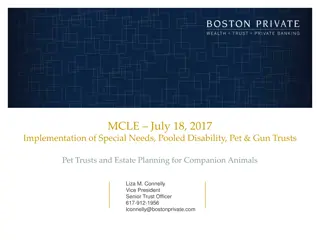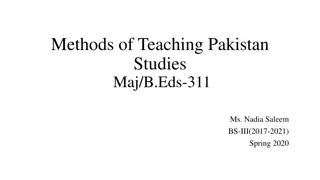Study on Abundance of Pet Dogs in Rawalpindi District, Pakistan
This study investigates the population of pet dogs in Rawalpindi District, Pakistan, highlighting the prevalence of rabies and dog-related incidents. Methodologies include surveys and questionnaires to compile data on dog ownership and behaviors. Results indicate educational disparities among respondents and provide insights for public health interventions to address rabies incidence and dog bites in the region.
Download Presentation

Please find below an Image/Link to download the presentation.
The content on the website is provided AS IS for your information and personal use only. It may not be sold, licensed, or shared on other websites without obtaining consent from the author. Download presentation by click this link. If you encounter any issues during the download, it is possible that the publisher has removed the file from their server.
E N D
Presentation Transcript
Abundance of pet dogs in Rawalpindi district of Pakistan S.I. Shah, M. A. Beg, M. S. Nadeem, A. R. Kayani and N. Rashid Department of Zoology, PMAS, Rawalpindi ,Pakistan 1
Contents Introduction Materials and Methods Results and discussion Recommendations Acknowledgment 2
Introduction Annually, 2000-5000 rabies deaths have been estimated for Pakistan 55-60 cases of dog bites per day occur in Karachi city and nearly 150000 dog-bite cases in Pakistan each year Rabies incidence was estimated to range between 7.0 to 9.8 cases per million annually in Karachi. This is only peer-reviewed published literature on the occurrence of rabies in Pakistan 75% of Govt. hospitals still using obsolete rabies vaccine There is no information available on dog population in Pakistan and this is first ever study on dog from Pakistan (Ali, 2003, Parviz et al., 2004, Salahuddin, 2009) 3
Materials and Methods Study Area-District Rawalpindi, Pakistan Administrative units 5285 Km2 3.3 millions Area Population (1998) Est. population (2011) 4.5 millions Population density Urban population Rural population Average household Total housing units Tehsils Union Councils Villages 07 170 1164 851.3/km2 53% 47% 6.5 person size 521507 Census units Census block : 200-250 households Census circle: 5 to 7 blocks Census charge: 5 to 7 circles Population census organization, Pakistan 4
Methodology Four Rawalpindi city census circles, seven town census circles and 16 villages were surveyed through questionnaire and interviews. The questionnaire was in Urdu language Questionnaire included information about the Owner s name, age and sex Number of people lived in household Number of dogs in the household Age of dog at adoption Rabies deaths in area Dog bites in household and its treatments Number of dog rabid in the area What people do after touching or handling dogs The information thus, collected was compiled and analyzed using Microsoft Access database and SPSS-16 software 6
Respondents general information Uneducated 10% Respondents education Higher education 18% Respondents sex Female, 129 Primary 17% Male, 1731 Matric 31% middle 24% 300 250 Respondents ages No. of questionnaire 200 150 100 50 0 13-22 23-32 33-42 43-52 Age groups (years) 53-62 63-72 73-82 82 and above 8
Table: Detail of areas selected for questionnaire survey in Rawalpindi district No. of households surveyed 82 51 82 69 284 29 16 56 26 34 32 47 240 72 72 104 70 87 85 73 72 87 79 92 83 94 85 98 83 1336 1860 People lived in households 676 357 571 478 2082 237 114 391 191 270 233 311 1747 598 540 765 480 595 625 517 611 662 579 619 565 697 676 731 637 9897 13726 People per household 8.24 7.00 6.96 6.93 7.33 8.17 7.13 6.98 7.35 7.94 7.28 6.62 7.28 8.31 7.50 7.36 6.86 6.84 7.35 7.08 8.49 7.61 7.33 6.73 6.81 7.41 7.95 7.46 7.67 7.41 7.38 Households that had dog/s No 78 50 78 53 259 14 8 36 18 17 19 31 143 40 44 58 43 54 44 37 40 44 37 49 54 53 50 53 49 749 1151 % No. Dog to human ratio 1 dog: n 135 357 114 20 59 10 13 13 21 11 17 15 13 13 15 12 13 13 12 13 12 11 11 11 16 13 12 12 12 12 14 Habitats No./Name Yes 4 1 4 16 25 15 8 20 8 17 13 16 97 32 28 46 27 33 41 36 32 43 42 43 29 41 35 45 34 587 709 Ownership 4.88 1.96 4.88 23.19 8.80 51.72 50.00 35.71 30.77 50.00 40.63 34.04 40.42 44.44 38.89 44.23 38.57 37.93 48.24 49.32 44.44 49.43 53.16 46.74 34.94 43.62 41.18 45.92 40.96 43.94 38.12 of dogs 5 1 5 24 35 24 9 31 9 25 14 21 133 47 37 65 38 47 51 41 50 61 52 55 36 53 57 59 52 801 969 3/22 4/18 4/26 6/12 Total 007/1211 902/1180 906/1180 301/1130 403/1130 902/1210 906/1210 Total Angrooi Bagha Shiekha Chak Beli Khan Ehata Islampur Jabbar Jatli Choha Khalsa Khinger Kalan Lohsar Sharfoo Lokot Maira Kalan Mussiari Narali Panjgraan Ranial Smote Total Overall total Rawalpindi city circles Gujar Khan Town circles Taxila town circles Murree town 'circles Villages of Rawalpindi district 9
120 Urban 98 100 Rural 89 88.9 85.5 77.2 74.1 73.7 80 72.8 69 67 62 66.7 57 54 54 60 53.1 53 42.18 42 39.8 40 22.65 16.2 16 20 12.3 9.65 11 8.8 0 Figure: Dog ownership pattern in urban and rural settlements of different countries (Source: Davlin and VonVille, 2012) 10
1000 148.8 Dog to human ratio (1=n) Urban Rural 100 59 45 35 37 25 16 12.5 12 11.4 11 9.9 7.2 7.45 6.9 10 6.7 6.7 6.3 5.2 5 4.6 4.6 4.6 4.5 4.5 4.7 4.3 3.8 3.4 3.4 3.15 1.7 1.2 1.1 1 Figure: Dog to human ratio (1:n) reported in different countries (Source: Davlin and VonVille, 2012) 11
Number of dogs per household Reason for hand wash after handling dogs 600 542 500 400 300 200 Hygenic reason, 320, 18% 125 100 16 15 11 0 1 2 3 4 5-6 Religious reason, 182, 10% Age of dog at adoptation 500 461 Both reasons, 1288, 72% 450 400 350 300 250 200 129 150 91 100 54 19 50 0 At birth 1-3 months 4-6 months 7-12 months 13-25 months 12
Table: Rabies deaths and dog bite cases reported in selected areas of Rawalpindi district Rabies death cases NA 5 2 0 1 8 0 0 0 0 0 0 2 2 0 0 1 0 0 1 3 1 0 0 0 0 1 1 3 0 11 1027 21 1483 Dog rabid No 69 49 67 64 249 5 12 6 31 12 17 20 103 20 27 52 27 44 18 29 17 33 31 43 37 35 21 45 34 513 865 Dog bite in household member NA 10 0 7 8 25 0 0 0 0 2 1 2 5 0 0 3 0 1 0 3 1 3 0 0 0 0 1 4 4 20 50 1351 Locality Name/No. 3/22 4/18 4/26 6/12 No 77 49 82 65 273 23 20 23 50 12 20 35 183 60 59 88 49 65 64 61 59 70 54 67 60 77 60 72 62 Yes 0 0 0 3 3 6 6 11 6 4 12 10 55 12 13 15 21 22 20 9 12 17 25 25 23 16 24 23 21 298 356 NA 10 2 9 0 21 0 0 0 1 0 0 4 5 0 0 0 0 0 0 2 0 1 1 0 1 5 0 1 3 14 40 Yes 3 0 6 5 14 24 14 28 24 4 15 23 132 52 45 52 43 43 67 42 55 53 47 49 45 54 64 52 46 809 955 No 70 51 73 58 252 20 18 23 48 10 21 33 173 47 46 78 47 64 59 55 48 60 54 70 60 65 51 69 53 926 Yes 2 0 2 3 7 9 8 11 8 4 10 12 62 25 26 23 23 22 26 15 23 24 25 22 23 29 33 25 26 390 459 Total 82 51 82 69 284 29 26 34 56 16 32 47 240 72 72 104 70 87 85 73 72 87 79 92 83 94 85 98 83 1336 1860 Rawalpindi city 'circles 007/1211 301/1130 403/1130 306/1180 301/1180 902/1210 906/1210 Gujar Khan town circles Taxila town circles Murree town circles Angroo Bagha Shiekha Chak Beli Khan Eihata Jabbar Jatli Juda Khalsa Khinger Kalan Lohsar Sharfoo Lokhot Maira Kalan Mesyari Narali Panjgraan Ranial Smoot Total Grand total Villages of Rawalpindi district 13
Rabies cases in Rawalpindi district Rabies deaths in human settlements Vectors caused rabies City, 3, 1% Others, 11, 3% Towns, 55, 15% Jackal bite, 30, 8% Dog bite, 315, 89% Village, 298, 84% 14
Dog bite in Rawalpindi district Treatments after bitten by dog 350 Spiritural treatments, 111, 24% Hospital treatments, 185, 40% 300 No. of people bitten by dogs 250 Spiritual plus hospital treatments, 114, 25% 200 No treatment, 49, 11% 150 Member of household bitten by dog 100 Adult female 68 15% 50 Male child 118 26% 0 female child 49 11% Adult male 214 48% 15
Summary 356/1860 households reported only 26 rabies deaths in all human settlements My study indicated 89% rabies deaths due to dog bite in Rawalpindi, Pakistan 459/1860 household respondents reported dog bites and it was associated with males (332 cases) After dog bites, 24% people got spiritual treatments only and 40% go to hospitals only and 25% did both while 11% did nothing about treatment Only 38.12% households were positive for pet dogs The overall dog to human ratio (1:n) was 1:14 16
Suggestions and recommendations 1. ABC program is in practice in many countries of the world and should immediately start in Pakistan 2. Vaccination of pet dogs should be carried out in villages as large number of pet dogs and dog bites are reported in the villages 3. Rawalpindi district is a hilly tract of land with relatively little agriculture. Hence the rural population of the district is small. So is also case with dog population. To know exact scenario of dog population, the similar studies should be conducted in other area of Pakistan. 4. Rabies caused deaths are more common in rural areas. Here good number of the people depend on spiritual treatments or local medicine men. Awareness programs for the villagers should be started. 5. Hopefully, WHO may help to start dog management program in Pakistan 17
Acknowledgements My PhD supervisor Prof. Dr. Mirza Azhar Beg Higher Education Commission to give me scholarship for PhD studies Population census organization , Pakistan to give me data on Rawalpindi district Authors (Davlin and VonVille, 2012) and Elsevier team to allow me to use the research article 18
References Study No 1 2 3 4 5 6 7 8 9 10 11 12 13 14 15 16 17 18 19 20 21 22 23 24 25 26 27 28 29 Author and publication year Acosta-Jamett et al., 2010 Awoyomi et al., 2007 Beran, 1982 Beran and Frith, 1988 Brooks, 1990 Butler and Bingham, 2000 Cleaveland et al., 2003 De Balogh et al., 1993 Durr et al., 2009 Estrada et al., 2001 Faleke, 2003 Fishbein et al., 1992 Flores-Ibarra and Estrella-Valenzuela, 2004 Hatch et al., 2004 Kaare et al., 2009 Kayali et al., 2003 Kitala et al., 2001 Knobel et al., 2008 Kongkaew et al., 2004 Matter et al., 2000 Ortega-Pacheco et al., 2007 Perera et al., 2007 Ratsitorahina et al., 2009 Rautenbach et al., 1991 Robinson et al.,1996 Sudarshan et al., 2001 Sudarshan et al., 2006 Suzuki et al., 2008 Touihri et al., 2009 Location Chile Nigeria Philippines Ecuador Zimbabwe Zimbabwe Tanzania Zambia Chad Philippines Nigeria Mexico Mexico Sierra Leone Tanzania Chad Kenya Tanzania Thailand Sri Lanka Mexico Sri Lanka Madagascar South Africa Philippines India India Bolivia Tunisia 19
THANKS SUGGESTIONS AND QUESTIONS SUGGESTIONS AND QUESTIONS 20

























